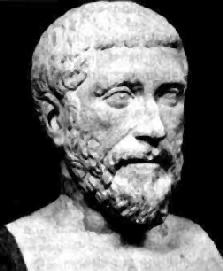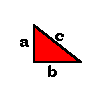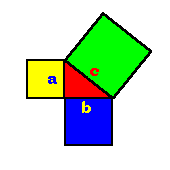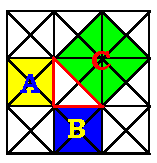Right Triangles - Pythagorean Theorem
 The Pythagorean theorem was first known in ancient
Babylon and Egypt (beginning about 1900 B.C.). The relationship was shown
on a 4000 year old Babylonian tablet now known as Plimpton 322. However,
the relationship was not widely publicized until Pythagoras stated it
explicitly.
The Pythagorean theorem was first known in ancient
Babylon and Egypt (beginning about 1900 B.C.). The relationship was shown
on a 4000 year old Babylonian tablet now known as Plimpton 322. However,
the relationship was not widely publicized until Pythagoras stated it
explicitly.
Pythagorean
 Pythagoras lived
during the 6th century B.C. on the island of Samos in the Aegean Sea. He also lived in
Egypt, Babylon and southern Italy. Pythagoras was a teacher and a philosopher.
Pythagoras lived
during the 6th century B.C. on the island of Samos in the Aegean Sea. He also lived in
Egypt, Babylon and southern Italy. Pythagoras was a teacher and a philosopher.
Pythagoras found out that for a right angle triangle (with one of the angles being 90o), the square of the hypotenuse is equal to the sum of the squares of the other two sides: a2+b2=c2.

In other words, the green square's area (with area c2) equals the sum of two others. It is exactly the yellow square's area (a2)
plus the blue square's (b2).

Now take a look at the tile pattern.
[The proof of Pythagorean Theorem is in the following figure.]

Count the triangles within the squares. The number of green triangles equals
the total of those that are yellow and blue!
Do You Know ...
Archeologists use the Pythagorean in field excavations. When they start a
dig, they place a rectangular grid over the site surface. To lay out an
accurate grid system, archeologists use the Theorem, X
2+Y2=Z2. After deciding how long the baselines
(X- and Y- axis) should be, the proper length of the diagonal is calculated
using the Pythagorean theorem to make sure the quadrant is a rectangle and
not a lopsided parallelogram. Corner stakes will then be placed to mark the
accurate location of the site.
An overlaying rectangular grid uses a
mathematical idea called Cartesian coordinate system.
 The Pythagorean theorem was first known in ancient
Babylon and Egypt (beginning about 1900 B.C.). The relationship was shown
on a 4000 year old Babylonian tablet now known as Plimpton 322. However,
the relationship was not widely publicized until Pythagoras stated it
explicitly.
The Pythagorean theorem was first known in ancient
Babylon and Egypt (beginning about 1900 B.C.). The relationship was shown
on a 4000 year old Babylonian tablet now known as Plimpton 322. However,
the relationship was not widely publicized until Pythagoras stated it
explicitly. 


